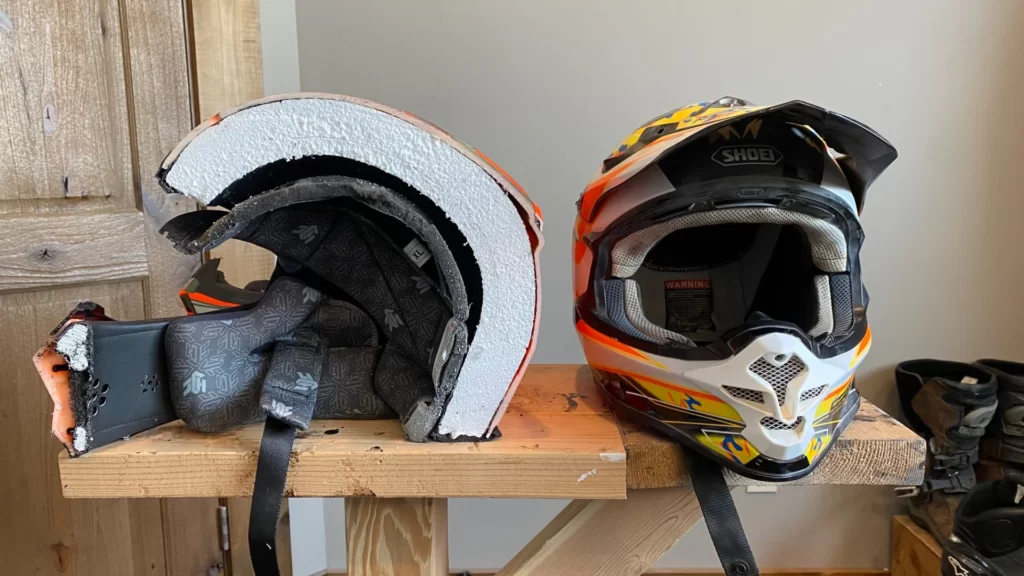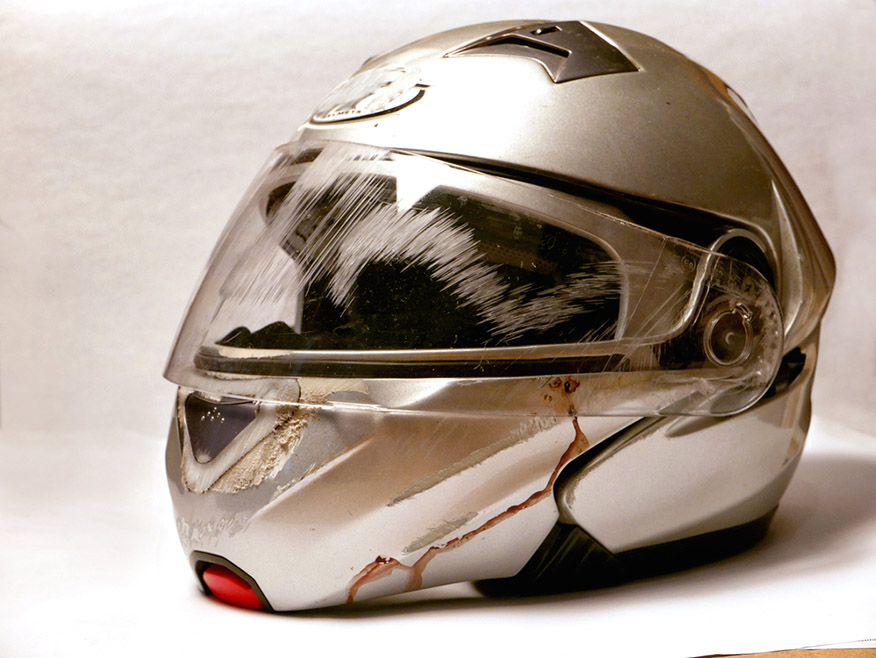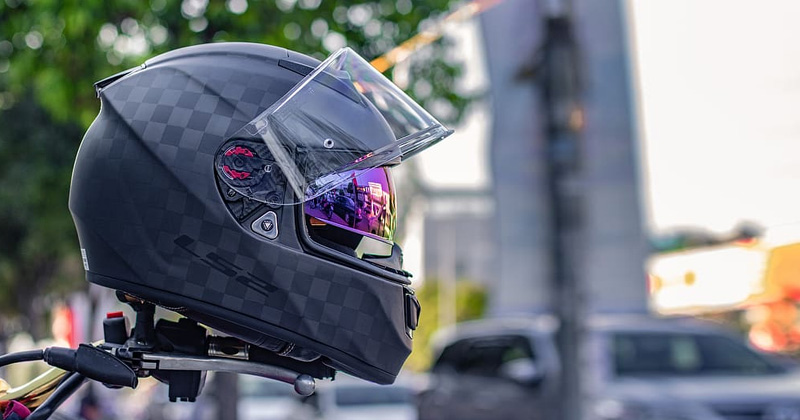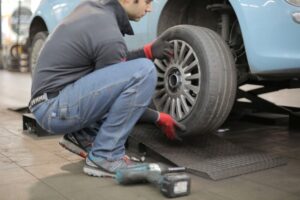A motorcycle helmet is the most important piece of equipment a motorcyclist can own. It protects us from head injuries, road debris, and bad weather. However, we tend to ignore them and can be misled by rumors about their durability and safety.
Helmets can degrade over time for a variety of reasons. Finding the right time to replace your helmet is all about how you store it, how often you use it, and the quality of the helmet itself.
How Long Do Motorcycle Helmets Last?
Although I wrote a short answer above for those in a hurry, it’s not as simple as stating that the helmet will expire in 5 years.
There are several very important considerations, which may mean the helmet will last longer, or indeed need to be replaced sooner.
However, helmet manufacturers generally agree to a five-year helmet replacement rule.
This is also supported by the Snell Foundation, a non-profit organization focused on research, education, and development of motorcycle helmet safety standards.
Some quality helmet manufacturers offer a 5-year warranty. This leads consumers to believe that the helmet is good and effective for several years after purchase, but this assumes that the motorcycle helmet remains in pristine condition and has not been dropped or involved in an accident.
So while 5 years is a good guideline, it’s definitely not a panacea. To understand why the 5-year rule shouldn’t be adhered to anyway, let’s understand why motorcycle helmets expire.
Why Do Motorcycle Helmets Have Expiration Dates?
The motorcycle helmet manufacturer’s stamp inside the helmet will let you know when it was made. Now that you know when it’s time to retire an old helmet, this information will keep you safe on the road. You can decide when to change your helmet, depending on how many times you ride and the environment you’re in.
What Causes Motorcycle Helmet Degradation?

Motorcycle helmets have a limited lifespan because the outer shell and inner lining materials used in the construction break down over time.
Now, different parts of the helmet will degrade at different rates, some more important than others. Additionally, how much a helmet is used and where it is stored when not in use can affect how quickly a helmet expires.
Let’s start with the basics, even putting on or taking off a helmet causes general wear and tear, all you do is use the helmet as intended.
Then we have to consider moisture, hair oil, and other bodily fluids, all these lovely things that are in our heads and in the cleaning products we might use that end up degrading materials in various places inside the helmet.
The best way to see why a helmet won’t last forever is to look at the various components:
Chin Strap
The chin strap of the helmet will wear out during normal use. The last thing you need is for the belt to fail when you need it most.
Maybe the chin strap can be replaced with extra parts from the manufacturer, so it’s not necessarily a reason to have to buy a brand new helmet.
Comfort Lining/Padding
The comfort liner also gets some abuse from the normal use of the helmet.
Helmet padding, especially around the cheeks, can set and lose shape over time, causing it to start to feel loose.
This isn’t too much of an issue, as the filler will fit your head/face shape after wearing it for a while, so you can expect a break-in period.
However, over a long period of time, the compressed padding may cause the helmet to be too loose and therefore not fit you.
Most importantly, your helmet needs to fit you, whether it’s a budget cap or a top-of-the-line Arai, and if it doesn’t fit, then it’s not fit for use in an accident.
The good news is that comfort pads/pads can usually be purchased from helmet manufacturers and can be replaced if your cheek pads are a little frustrated and no longer doing the job.
The actual comfort pads themselves may wear out from wearing/taking off helmets, using glasses, masks, etc. All of these can cause the comfort pad to wear out.
Even shampoo/conditioner/hair care products and makeup can have an effect on the lining and end up wearing out like any fabric clothes/accessories.
Depending on how the helmet is used, replacing the inner liner may be a cheaper way to renew the helmet rather than buying a new one. Especially if you’re using the helmet every day and it hasn’t been in an accident or dropped.
However, if you don’t ride every day and your lining is worn out, this could be a sign that it’s time to replace, just as the comfort lining is worn out and barely used, it could be an indication that the EPS lining is also tired.
EPS Liner
EPS is the most commonly used lining material and is an abbreviation for expanded polystyrene, also known as Styrofoam. This is one of the most important components of the entire build. Therefore, this is also the most important point when deciding whether or not to replace it.
The Styrofoam liner is the layer between the outer shell and the inner padding. It cannot be removed from the helmet, nor can it be replaced.
However, dispelling this misconception is important as it can degrade and break down from the oils, sweat, and everyday chemicals we use on our face and hair. This is not the case, the EPS liner will outlast any other component on the helmet and retain its protective properties for a considerable amount of time.
It’s hard to know if it’s damaged or degraded, so it’s not an indicator of whether you need to replace your helmet.
The main thing to be aware of is that if you drop the helmet or have an accident that ends up hitting the helmet, you don’t know if the layer has been damaged, so be sure to buy a new helmet.
Some helmet manufacturers, like Schuberth, will actually allow you to send the helmet back to them, and they’ll scan it to check that the structure is intact and safe, similar to an X-ray inspection.
However, you’ll have to contact individual manufacturers through your dealer to see if this is possible.
A few years ago, while working at a motorcycle shop, a customer came in with a helmet he had cut out of the Styrofoam lining so he could fit some earbuds.
Please don’t do this, it’s meant to absorb shock to your head in the event of an accident, shaving the pads means your head will absorb more energy.
Outer Layer
However, the outer shell of a helmet can degrade and wear out for a number of reasons, but the main one is that prolonged UV exposure makes it brittle and ineffective.
The main materials for the production of housings are polycarbonate and ABS (thermoplastic), fiberglass, carbon fiber, and Kevlar composites.
Thermoplastics are widely used in helmet production, usually on the lower-cost end. Polycarbonate is particularly affected by UV light, but manufacturers have started adding stabilizers to the process to help control the problem.
The problem is that stabilizers don’t last forever, eventually, the outer layer will degrade and fail.
The shell is the first point of impact in an accident, so it must be kept in top shape.
Glue
Another reason helmets can expire is that the glue that holds all the layers together ends up being affected by all these oils, chemicals, makeup, sweat, etc.
Eventually, the layers can separate, and the last thing you want is for the outer layer to separate from the Styrofoam in an accident. This process takes a long time, but it is important to be aware of it.
Other Reasons Motorcycle Helmets Expire
- Weather – rain/sun exposure are the main reasons helmets get worn down quickly, if you commute every day in all weather, replacing your helmet regularly is a very good idea.
- Climate – if you ride in extreme heat, humidity, or extreme cold these are all factors that will affect your helmet’s lifespan, especially if you go from one to the other quickly.
- Cleaners, fuel, road debris, and other commonly encountered materials can degrade your helmet.
- Dropping or being involved in an accident, you should replace your helmet immediately.
- Every year there is a noticeable improvement as helmet technology evolves, and after 5 years of wearing the same helmet, you will be amazed at the new features that a new one can offer.
Signs That a Motorcycle Helmet Is Too Worn Out?

First, you should never consider buying a used bike helmet. Even if it doesn’t look worn at first glance, there may be damaged parts.
Also, in any weather conditions, the helmet will be attached to the person’s head and the lining will absorb their sweat, oil, hair, etc. These liquids can seep into the protective lining, weakening it, making the helmet less protective and even a little rough.
Regarding your helmet, you know better than anyone how worn it is, and you should know how effective it will be in a crash. If you have any concerns, you can check your helmet or that of your riding partner by:
- Documenting the history of helmets
- Semi-regularly check the manufacturing date of the helmet
- Check the shell
- Check shock-absorbing bushings
- Make sure the chin strap is fully functional
- Regularly inspect the structural integrity of the helmet
Motorcycle Helmet Care and Maintenance
Motorcycle Helmets are expensive, but they are an essential safety device that will likely save your life in the unfortunate event of an accident.
As such, it should be treated with the utmost respect and care, and this is a project that deserves as much TLC as your beloved motorcycle itself.
Here are some top tips for keeping your helmet in good shape so that it works well:
- Store it in a dry place (preferably under a lid), out of direct sunlight, and out of humidity or extreme temperatures.
- Don’t use it as a storage basin for gloves, handkerchiefs, keys, or anything else you can think of. These items can damage the inner layer and it is very unhygienic to put riding gloves in a helmet and then put them on your head.
- Pay close attention to the chin strap, goggles, inner goggles, and any moving parts, make sure they are all secure, don’t come loose, and replace them if they are, and if possible.
- Don’t do DIY work on the EPS lining, it shouldn’t be cut or carved out, and the same goes for the inner lining.
- Check the case for any cracks or paint spots, if you find any, you need to replace it because you don’t know how the case is affected at a deeper level.
- Keep the lid clean! There are many products to keep it fresh and clean. Most comfort pads are removable and can be washed in the machine or by hand, so it’s always worth doing, especially if you ride a lot. Keeping the visor/shell free of dirt, water and bugs will go a long way toward its longevity.
Final Thoughts
Motorcycle helmets don’t last forever, but with proper care and attention, they can last for years. Take care of it like a motorcycle and it won’t let you down when you need it the most.
It’s also important to replace it when you need it – whether it’s because you’ve had it for over 5 years or because you gave it up, it’s not worth the risk.



